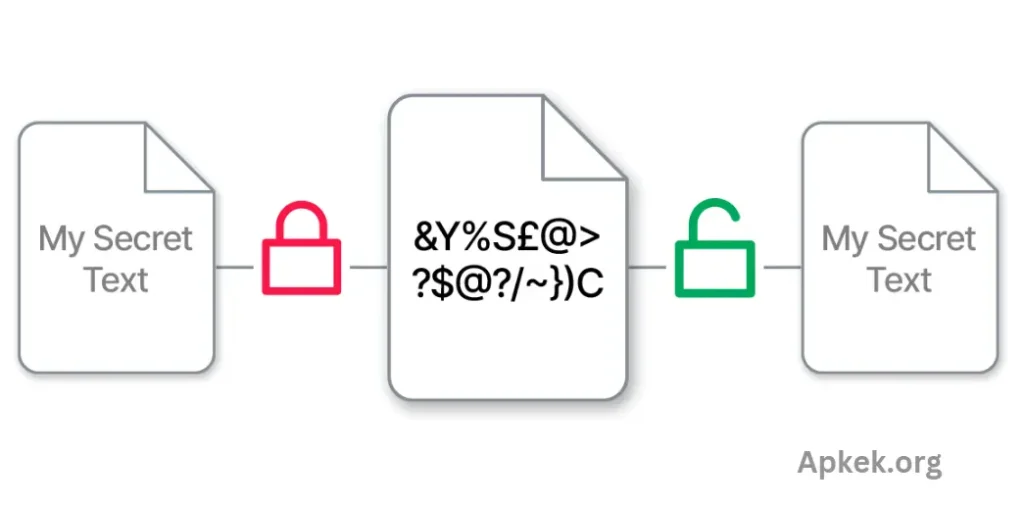A significant amount of sensitive information is shared via SMS. However, if that information is seen by unintended parties, its confidential nature could be compromised, potentially leading to unwanted consequences.
Our website is dedicated to addressing this concern by offering valuable solutions to enhance your privacy and security.
We frequently publish articles focused on mobile applications, specifically curated for users who prioritize data protection. These applications are carefully selected from the Google Play Store, ensuring that you receive trusted, effective tools to safeguard your communications.
What is Text Message Encryption?
Text message encryption is the process of converting a readable message into an unreadable format to protect it from unauthorized access. The goal is to ensure that even if someone intercepts your message during transmission, they will not be able to make sense of it.
Encryption uses algorithms to transform the original message, also known as “plaintext,” into an unreadable format called “ciphertext.” Only the recipient, who possesses the proper decryption key, can decode the message and read its original contents.
There are two main types of encryption:
- Symmetric Encryption: The same key is used to both encrypt and decrypt the message. While it is fast and efficient, both the sender and the recipient must securely exchange the key beforehand.
- Asymmetric Encryption: This method uses a pair of keys – a public key for encryption and a private key for decryption. Even if someone intercepts the encrypted message, they won’t be able to decrypt it without the private key. This type of encryption is more secure, especially for public communications.
Why is Text Message Encryption Important?
- Protecting Sensitive Information: Text messages often contain personal, financial, or confidential data. Whether it’s a password, bank account details, or a business contract, encryption ensures that this information remains private and secure.
- Preventing Unauthorized Access: Without encryption, text messages are vulnerable to interception by hackers, unauthorized third parties, or even malicious apps on your phone. Encryption shields your data from such threats, reducing the chances of unauthorized access.
- Maintaining Legal Compliance: In many industries, maintaining the confidentiality of communications is not just a best practice – it’s a legal requirement. Encryption helps businesses comply with data protection laws and regulations such as GDPR, HIPAA, and others.
- Fostering Trust: When users know that their communications are encrypted, they are more likely to trust the service or platform they are using. This fosters a sense of security and encourages the use of mobile messaging for a broader range of tasks, from personal conversations to business transactions.
What is Text Message Decryption?
Decryption is the reverse of encryption. It involves converting the encrypted message (ciphertext) back into its original, readable format (plaintext). This can only be done by the recipient who has the correct decryption key. Decryption ensures that even if a message is intercepted during transmission, it remains protected from unauthorized access.
In most modern encryption systems, decryption is done automatically as soon as the recipient receives the encrypted message. All they need is access to the necessary decryption key (which is often kept secure and private) to access the original message content.
How Does Text Message Encryption Work?
Here’s a simple breakdown of how encryption and decryption work when sending a text message:
- Sending a Message:
- The sender types a message, which can be anything from a simple text to more sensitive information. Before sending, the app uses an encryption algorithm to convert the message into ciphertext using an encryption key (public key for asymmetric encryption).
- Transmission:
- The encrypted message is sent over the network to the recipient’s device. Even if the message is intercepted, the intercepted data is unreadable without the proper decryption key.
- Receiving the Message:
- Once the recipient receives the encrypted message, their device uses the corresponding decryption key (private key) to convert the ciphertext back into the original message format.
- Reading the Message:
- Finally, the recipient can read the message in its original, readable form.
You may also like it:
Use One Chat & Secure Your All Chat
Any Language Bubble Screen Translate
Why Use Status Post Scheduler for WhatsApp
Popular Apps for Text Message Encryption
While many messaging apps offer built-in encryption, not all provide end-to-end encryption, which is the gold standard for secure communication. End-to-end encryption ensures that only the sender and recipient can read the messages, and not even the service provider can access the content. Here are a few apps known for their encryption features:
Signal:
Signal offers end-to-end encryption for all messages and calls. It’s an open-source platform, meaning its code is publicly available for review, and it is considered one of the most secure messaging apps available.
WhatsApp:
WhatsApp uses end-to-end encryption to protect messages, media files, and voice calls, ensuring that only the sender and recipient can access the content.
Telegram:
Telegram offers a secret chat feature with end-to-end encryption, although standard chats on Telegram are encrypted server-client (meaning Telegram has the ability to decrypt messages if needed).
iMessage:
Apple’s iMessage service also offers end-to-end encryption for messages sent between Apple devices, ensuring that communications remain private.
ProtonMail:
While not a text message service, ProtonMail offers end-to-end encryption for email communication, which is often used alongside text messaging for secure communication.
How to Protect Your Text Messages
While encryption provides robust protection, there are other practices you can adopt to safeguard your text messages further:
- Use Secure Apps: Always opt for messaging apps that provide end-to-end encryption, ensuring that no third parties can access your communications.
- Enable Two-Factor Authentication (2FA): Using 2FA for your messaging apps adds an extra layer of security in case someone tries to access your account.
- Be Cautious of Phishing Scams: Always verify the identity of the person you’re communicating with, especially if they ask for sensitive information.
- Update Your Software Regularly: Ensure your device and apps are up-to-date with the latest security patches to protect against known vulnerabilities.
- Avoid Public Wi-Fi for Sensitive Messages: Public Wi-Fi networks can be less secure, making it easier for hackers to intercept your messages. Always use a VPN (Virtual Private Network) or avoid sending sensitive information on public networks.
Frequently Asked Questions
What is text message encryption?
Text message encryption is the process of converting a readable text message into an unreadable format using a cryptographic algorithm. This transformation ensures that even if the message is intercepted during transmission, it cannot be read by unauthorized parties. Only the recipient, who possesses the decryption key, can convert the message back into its original form.
How does text message encryption work?
Text message encryption works by applying a mathematical algorithm to transform the message (called plaintext) into an encrypted format (ciphertext). The encryption algorithm uses a key, which is a piece of information (like a password) that is required to both encrypt and decrypt the message. When the recipient receives the encrypted message, they use their private key to decrypt it back into readable text.
Why is encryption important for text messages?
Encryption is crucial because it protects your text messages from unauthorized access. Without encryption, messages can be intercepted and read by hackers, criminals, or even third-party apps. By encrypting your messages, you ensure that sensitive information, such as personal details, financial data, or business-related content, remains private and secure.
Can encrypted text messages be intercepted?
While encryption significantly reduces the likelihood of successful interception, it does not make your messages 100% immune to interception. However, without the decryption key, the intercepted message will appear as gibberish and cannot be read by unauthorized individuals. As long as encryption algorithms are strong and the encryption key is kept secure, the risk of interception is minimized.
Do all messaging apps encrypt text messages?
Not all messaging apps encrypt text messages by default. However, several popular apps like Signal, WhatsApp, and iMessage offer end-to-end encryption, meaning the messages are encrypted on the sender’s device and can only be decrypted by the recipient’s device. Other apps may offer encryption, but not all of them provide end-to-end encryption, which means that the service provider could potentially access the messages.
What is end-to-end encryption?
End-to-end encryption (E2EE) ensures that a message is encrypted on the sender’s device and can only be decrypted on the recipient’s device. No third party, including the service provider, can access the content of the message. This level of encryption is essential for ensuring privacy and security during communication.
Conclusion
Protecting the privacy of what we share has become more critical than ever. Text message encryption and decryption provide a strong line of defense against unauthorized access, ensuring that sensitive conversations remain confidential and secure.
Whether you’re exchanging personal details, business information, or private thoughts, encryption transforms your messages into secure data that only the intended recipient can read. Decryption, on the other hand, brings those messages back to life safely, only on the right device, with the correct key.
By using trusted apps with end-to-end encryption, staying updated on security practices, and understanding how encryption works, you take control of your digital privacy. As cyber threats evolve, encrypted messaging is no longer optional—it’s essential.

